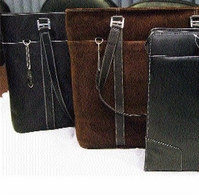

What if, instead of number crunching or organising work flow, your talent lay in, say, natural talent - the artistic ability to create, backed by the commercial sense of what clients would pay top dollar to acquire.
If you had that talent, your input into developing a business might involve no more than gathering your raw materials, getting to work, and then finding a market for what you have produced.
If you don't - and sometimes even when you 'think' you do - the Jamaica Business Development Corporation (JBDC) suggests that you err on the side of caution and seek technical training in order to reduce wastage and ensure quality.
One creative area for which this organisation has produced a business guide is leather craft. The general principles can be applied to other creative crafts as well.
training

Patent-leather shoes on display. – File
For leather craft, training will cover the skills of cutting, skiving - ensuring that pieces are straight and even - folding, stitching, joining and finishing.
Leather craft in demand includes key rings, purses, passport holders, cheque-book covers, wallets and billfolds, handbags, pouches, belts, sandals, eyeglass cases, watchbands, desk pads, earrings, armbands, and many other items.
Added to the basic leather in most of these items are artistic designs, with souvenir items often including palm trees and Jamaican phrases.
All items are expected to be attractive and light.
It is also noted that there is a special demand for high-quality, custom-made products, such as portfolios, notepad holders and other business items which are given as gifts to executives, business visitors and also given out at conventions and special events.
leather-craft equipment
For leather craft, equipment required includes a sewing machine, a skiving machine or edge-cutter edge, beveller or skiving knife - all intended to ensure that edges are even and straight.
You will also need a leather tool set, a revolving punch to make holes in tough leather, alphabet tools, which are used to stamp letters and numbers, a shoemaker's knife to cut leather into the desired pattern, and needles for the hand-stitching, which is often required.
These are minimum requirements.
Your raw materials for leather work will include the actual leather, lining, gum, buckles, fasteners, dyes, neatlac, which is used to provide sheen, thread and zippers.
You will also have to learn to organise your workshop in such a way as to maximise efficiency.
For staffing, you may require one person to do cutting, and another for stitching, etc, depending on the volume of production.
Quality control is important and all workers must be trained and well supervised.
Before or while you organise your workshop, you will need to find clients who may be found among gift shops, craft shops, boutiques and department stores, as well as craft wholesalers who often resell to gift shops.
The JBDC guide states that customers desire quality most of all, but they also need variety.
They will want to be supplied with new designs over time. You will also need to visit each client periodically to check on his or her level of satisfaction.
seasonal changes
Craft items may be affected by seasonal changes with peak seasons, including Christmas, when gift purchases are at peak and when gift shops stock up for the December to April tourist season.
Craft fairs are also excellent places to market and sell your products. Make sure, as well, to stamp and label your products with your name and address. In other words, brand your creations.
For information on general input costs and how to calculate expenses, the JBDC offers advice on working-capital requirements as well as record keeping required to keep track of sales and facilitate loans and grants for your business.
avia.collinder@gleanerjm.com